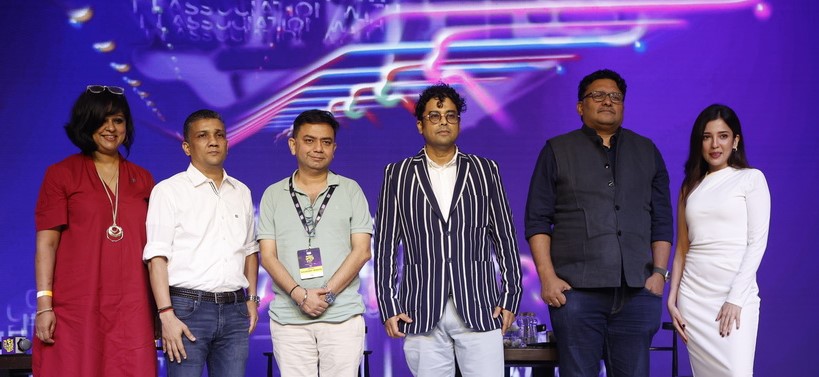The India Web Fest Season 6 concluded a few days ago. It assembled some fine dignitaries from multiple facets of the entertainment space and came together to have insightful conversations about various topics.
One such topic was the idea of entertaining young audiences with new-age content and this panel was moderated by Ms. Aarti Singh, CEO, Good Times; while the panel included Mr. Amogh Dusad, Head Content, Amazon miniTV; Mr. Vijay Koshy, President, TVF; Mr. Saurabh Tewari, CEO, Parin Multimedia; and Barkha Singh, Indian Actor.
Here are some excerpts from the conversation-
Aarti: A data scientist recently informed me that there are approximately 600 million Millennials and Gen Z individuals in India. Out of those, 70% consume an average of three and a half hours of content daily across streaming platforms and social media. That’s a massive amount of content consumption. If we can’t figure out what this audience wants, we risk falling behind. Today’s conversation is with a few industry experts, and I’m excited to uncover what India is watching right now. I will start with you Vijay, it seems TVF has cracked this. what is your take?
Vijay: India is watching a lot, but it’s a very broad question. I’d say India is consuming content across multiple platforms, and it’s not just about one medium like television or the web. Whether it’s fiction, non-fiction, or user-generated content, the landscape is vast and constantly evolving. What worked yesterday may not resonate today. At TVF, our mantra is “Lights, Camera, Experiment,” and that experimentation has worked well for us. Our journey began with YouTube, we continue with YouTube. We start on platforms like YouTube, see what clicks with audiences, and then develop further for other mediums. I don’t think there is a way to bracket it, what it that you want to do and what is your journey about is what matters. We at TVF have met with a moderate sense of success, as we have been doing it for 13 years, and I am hoping we continue to do that.
Aarti: Amogh, you tell me since you’re working with free-to-access platforms, what trends are you seeing among young Indian audiences?
Amogh: I think, barring Barkha on this panel, we three grey-haired people are talking bout young people and their references is ironic (laughs). But I would like to add to what Vijay said. What’s really changed is how content is consumed. With smartphones and cheaper data, people carry what is essentially a personal television in their pockets. Content consumption has become an all-day activity, from watching videos during commutes to binging late at night. This shift has led to more types of content and new formats, all tailored to fit different times and moods throughout the day. More and more kinds of content are coming out and they are also trying to fit into this jigsaw puzzle of what mood, what state and so on to cater to the consumer.
Aarti: Saurabh, when you are choosing concepts, how do you make sure that the young audiences will like it?
Saurabh: I think the way the audience is evolving like in every six months, I think the process is also evolving. For instance, Amogh and I worked on a project for Amazon miniTV which was called, Dehati Ladke. We had lots of debates as to what exactly the show should be called – should we call it Dehati Ladke and will it be aspirational enough? And that was the chance that we took. It turned out to be a hit because today’s youth want their stories told in their language, not ours. They take pride in their backgrounds, and stories need to reflect that pride. They don’t want aspirational stories handed to them; they want their own lives and struggles to be seen as aspirational. There was a problem earlier when someone said that I belong to Fatehpur or some smaller town or village no one has heard of – when it comes to migration or so. One would say that I belong to Lucknow or Delhi and so on. Now that has changed and there is no shame – you have to tell my legacy, my story. I think that is one thing we need to keep in mind when we are shortlisting concepts.
Aarti: Barkha, as an actor who has a lot of content for the youth, can you highlight the same?
Barkha: I think audiences are consuming everything, from short-form content made by individuals in small towns to full-length web series and films. Irrespective of your socio-economic background, I think people are doom-scrolling short format reels made by someone sitting in a village in Bihar or some aunty making yummy food in Kerala. So, we are watching everything as long as you can hold the viewer’s attention. I think our tolerance spans are lower than how it was a decade ago and hence we need to take care of that. What’s changed is the sheer amount of choice, which has shortened attention spans. As long as content can capture that attention—whether through relevant information, entertainment, or pure fun—it’s going to be watched.
Watch the full video below-
Presented By: Havas Play
Powered by: Applause , Epic On , OTT Play
In Association with: Shemaroo
Partners: One Digital Entertainment , Kaans , White Apple
#IndiaWebFest #IWMBuzz #OTTconclave


